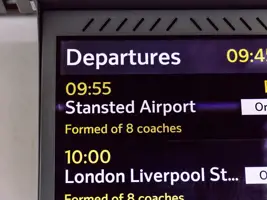The ultimate guide to the attractions of London!
Environmental benefits of travelling by train
19th May 2022
Why travel by train?
Transport makes up the largest part of the carbon footprint for most individuals. And most of that is down to having to travel – to work, into town, to visit friends and family in another part of the country and even beyond borders.
In fact, transport makes up 27% of all UK carbon dioxide (CO2 emissions), according to the Department for Transport, but trains are responsible for just 1% of that.
Do you regularly find yourself hailing a taxi, heading for the airport, or taking journeys by car? If so, you might want to consider how, by changing your mode of travel, you can cut back on your CO2 usage.
Did you know that taking a train for all or part of your journey is the most eco-friendly (apart from walking or cycling, of course)? That’s because, according to data from the UK Government’s methodology paper for greenhouse gas reporting, using the train instead of a car for a reasonably long journey could cut carbon you use by as much as 80 per cent. Using the train instead of a domestic flight would result in an 84% carbon saving.
The more passengers, the better the carbon footprint
The website Ecopassenger, which allows you to calculate the carbon cost of your journey, has worked out that taking a flight from London to Paris costs around 122 kilograms of carbon dioxide per passenger. That compares with just 8.3 kilograms per train passenger. Not only that, one train can mean 500 fewer cars on the road because one train can carry as many as 50,000 people per hour, compared to just 100 people per domestic flight. Your typical motorway moves around 2,500 people per hour.
And what about travelling by sea? After all, it’s possible to get a ferry from the UK to France and then drive on to Paris. It wasn’t always easy to calculate CO2 emissions for boats due to taking into account freight, motorists and foot passengers.
But, the Department of Energy and Climate Change (DECC) and the Department for Environment, Food and Rural Affairs (DEFRA) have recently devised a method of calculating this. This is worked out based on weight; each ferry foot passenger is estimated to emit 22.54 grams of CO2 per single journey. So, travelling by boat still uses more CO2 than by train.
Find out how much you can reduce your carbon footprint with our carbon calculator.
Many variables to take into account
The calculation varies depending on how many people are using the train or plane etc., or the number of passengers in the car.
In the end, though, driving a car and flying by plane use the most carbon of all journeys. Choose to fly, and you will use up more carbon if your journey is a short to medium one (i.e. a domestic flight). Take your car on an international trip, and you will use more carbon than flying long-haul abroad. It may seem confusing until you realise that a shorter, domestic flight from London to Glasgow uses up more carbon than an international journey from London to New York, because the plane needs much more fuel for take-off and landing than it does for cruising at altitude.
When driving, use a small car and the more, the merrier
Make your journey driving a small car, and you will emit 111g of CO2 (equivalent) per km. A large 4x4 Discovery-type vehicle emits 200g per km, but if there’s a passenger with you, then you can halve the emissions level. Why? Because you are car sharing, i.e. the same amount of carbon is getting two people to the same destination. By the same token, a car with four people means you can halve it again, so each individual only uses 25% of the car’s carbon emissions.
And then there is the matter of fuel when calculating carbon use. If the car is of average size and runs on petrol, it will produce around 180g of CO2 every kilometre, while a medium-sized diesel car produces 173g of CO2/km. If the car’s electric, your carbon emissions reduce to 60g per kilometre.
But even if you already know what fuel the car or mode of transport you are taking runs on, do you know where it comes from? For instance, if the fuel is electric, is it from coal or renewables? All trains in Switzerland run on electricity, for example, while around 50 per cent of all European trains are built this way too. But even more eco-friendly than electric-run trains are those powered by hydrogen. The Coradia iLint is the world’s first hydrogen-fueled passenger train, and it can be found in both Germany and Poland.
Book in advance for train journey savings
You can reduce the costs of travelling by train by planning and booking your journey well before your trip. That way, you can take advantage of special promotions and ‘early bird’ discounts.
And you don’t even have to go to the station or call to reserve your ticket. Simply book online and download your e-ticket, which you can then present to staff via your smartphone (there’s a carbon saving there too, of course - as you’re not printing off a paper ticket).
So book early for any trips you’re planning on taking in 2023 and save yourself some cash and be kinder to the planet in the process.




